Roast Venison with Bavarian Dumplings
December 25, 2012 | Updated July 27, 2022
As an Amazon Associate I earn from qualifying purchases.
Roast venison is a wonderful meal for weekends or special occasions, and this recipe will walk you through what you need to know both for roasts, and for a whole deer leg, if you have a small animal.
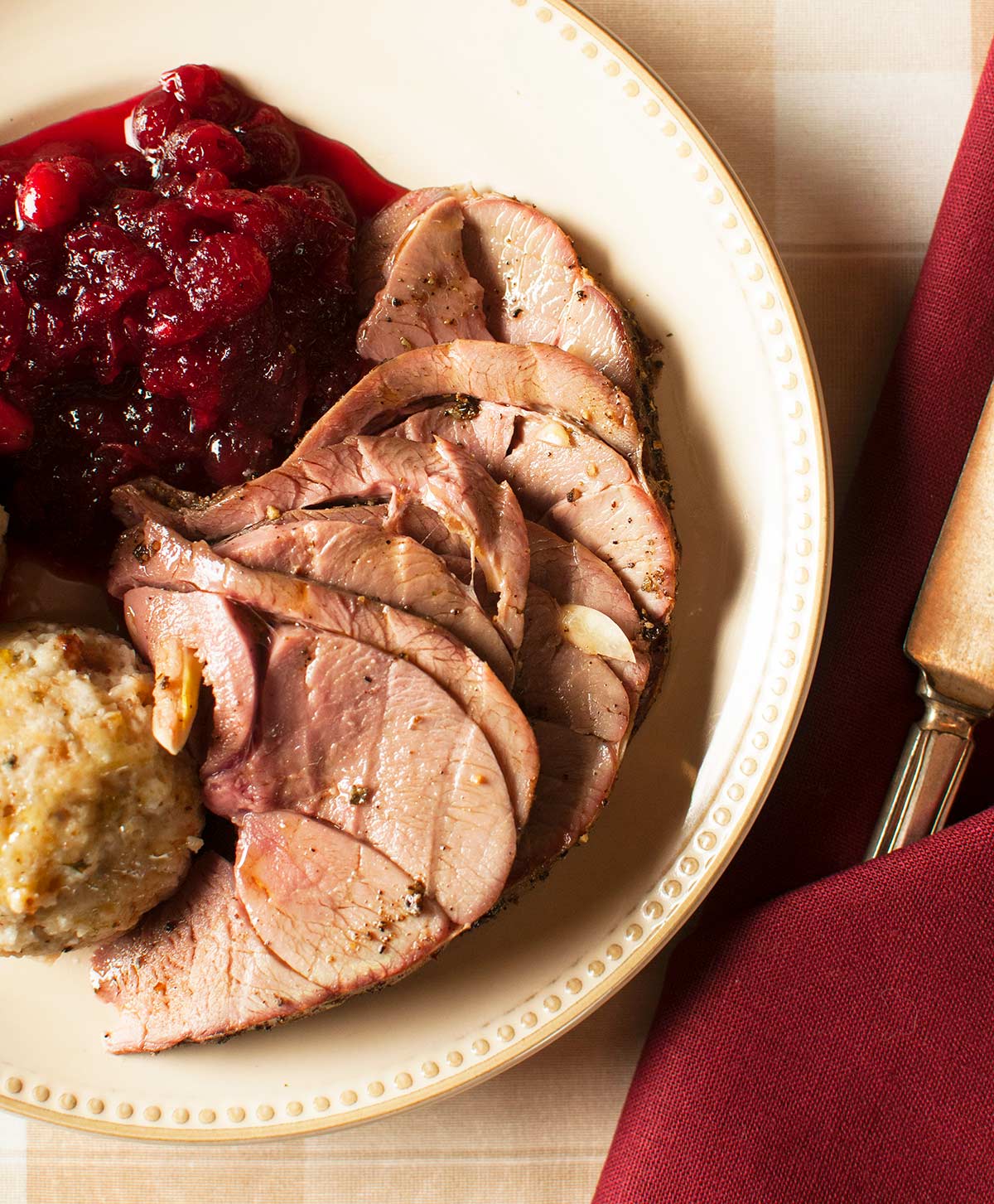
To answer the question you might have in your head right now, yes, the meat in the picture is a little pale. That’s because this roast comes from a yearling antelope I shot in Wyoming; younger animals have paler meat. Think veal, but more humane.
This recipe works really well with a whole antelope or deer leg if you have small ones, like yearlings or Sitka blacktail in Alaska. But most of the time we’ll be using roasts from the hind leg. Hind leg roasts are by far the best cut of meat for roast venison because you can cook them to an internal temperature of about 135°F, or medium-rare.
Roast Venison is Not Pot Roast
What you are reading is a guide to roasting venison so it’s nicely cooked, not hammered. I love pot roasts, which are hammered, and I have a great recipe for venison pot roast. But that sort of dish is best done with venison shoulder, neck or shanks, not hind leg roasts — the reverse is also true.
What follows is the traditional way to make roast venison, a method of cooking that has been used forever. There is an alternate method, however, which is reverse searing. In this method, you slowly cook a venison roast until it’s close to the target temperature, then you sear at the end. I have a recipe for reverse seared roast venison here.
To be honest, I had hesitated to post a recipe for roast venison because roasting large joints of meat is more of an art than a science. In few other areas of cookery are recipes more suggestion than manual. It’s not brain surgery or anything, but you do need to be watchful when roasting a large joint of meat.
And true roasting requires the radiant heat of an open fire, and if you are ever lucky enough to eat a haunch of venison properly roasted over such a fire, you will never forget it. Texas barbecue comes close, but only in a galactic sense.
What most of us do is technically baking, but it still creates wonderful results if you know what you are doing.
Tips for Better Roast Venison
I begin any roast by bringing the meat (or deer leg) towards room temperature. Roasting a cold joint of meat is a very, very bad idea. You get a charred exterior with a cold center if you do, and unless you enjoy this, you will be sad.
I also salt early and often. Salt when the meat is resting before cooking, salt in whatever rub I happen to be using, and salt when you serve. Adding salt little by little as the meat roasts makes it taste more of itself; adding it all at the end makes the meat taste of salt.
Venison is lean, so you need some sort of fat. Can you drape bacon over the roast as you cook? You bet, but only do it after you have done an initial sear, otherwise the exterior of the meat will look gray and unhappy.
Speaking of the initial sear, I prefer to get there by starting the roast in a roaring oven, somewhere between 450°F and 500°F. The smaller the roast, the hotter the oven. I roast the venison for at least 15 minutes this way, and up to 25 minutes. Then I drop the temperature to a more moderate 350°F. I wait until this point to add spices and herbs to the outside of the meat — if you add them in the beginning, they can burn and become nasty and bitter.
This is also a good time to drape that bacon over the roast, or baste it with fat or oil; melted beef fat is a great option.
Nailing It
Up to this point, you can follow a recipe verbatim. Finishing the roast venison requires attention and an eye for doneness, however.
For whatever reason, heat does not seem to increase in a linear fashion with roasting meat. I’ve tested a roast and have had it at 110°F and then a mere 10 minutes later have seen it jump all the way to 140°F. Not sure what’s going on here, but it happens. A lot.
I’ve used the fancy probe thermometers that Alton Brown champions, and they are very useful: You can pretty much stand there and watch the temperatures rise at the center of your roast. But if you don’t have one, you just need to be vigilant.
When in doubt, pull the meat early. You can always put it back in the oven. Roasts, no matter what meat they’re from, are serious, expensive pieces of meat. Letting one get away from you can ruin a holiday meal.
Resting Roast Venison
Finally, for the love of all that’s holy, rest roast venison thoroughly.
If you do not, all the juices will flow out of the meat and onto your cutting board. It is an unforgivable sin. Wait and you will be rewarded. How long? At least 10 minutes, even in an emergency. For a typical roast of between 4 and 6 pounds, 20 minutes is about right. Even 30 minutes is not too long.
As for carving, I find that bone-in roasts are best carved in large hunks — take a big hunk off the deer leg first, then carve into serving slices. Boneless roasts can just be sliced.
If you’re looking for other ways to cook large cuts of deer, here are more recipes for venison roasts.
Roast Leg of Venison
Ingredients
- 4 pounds venison roast
- Salt
- 6 to 8 garlic cloves, peeled and cut into thick slivers
- 1/4 cup squash seed oil or other flavorful oil (see below)
- About 1 cup of red wine, stock or water
- 2 tablespoons minced sage
- 2 tablespoons freshly ground black pepper
GERMAN DUMPLINGS
- 10 ounces stale bread
- 1 teaspoon salt
- 1 1/4 cups milk
- 3 slices bacon
- 1/4 cup minced shallot
- 1 tablespoon minced parsley
- 1 teaspoon marjoram
- 2 eggs, lightly beaten
Instructions
- Take the venison leg out of the fridge and salt it well on all sides. Let it sit on a cutting board for 30 to 45 minutes before proceeding. After 30 minutes have elapsed, preheat the oven to 450°F. Take a sharp knife with a narrow point and jab holes all over the roast or leg of venison, tucking a sliver of garlic into each hole. You can use more or less garlic, depending on your taste.
- Pat the venison dry, then massage the oil all over it. Set the roast or leg of venison on a rack in a roasting pan and pour enough wine, stock or water into the bottom of the roasting pan to just moisten the bottom -- don't cover the bottom or the meat will steam. You just want to limit the amount of smoke you will be producing. Put the venison in the oven and roast until it is nicely browned, but no more than 20 to 25 minutes.
- Take the venison out of the oven and drop the temperature to 350°F. Carefully sprinkle the minced sage and black pepper all over the roast; use tongs to pick it up if it is too hot. If you want, drizzle a little more oil over the top of the roast. Adding the spices at this point prevents them from burning.
- Set the venison back into the oven and roast until the deepest part of the meat reaches the temperature you want: If you pull the venison at 125°F, it will be rare once it has rested. I pull mine at 130°F, which is closer to medium. Do not let the venison cook past 145°F under any circumstances, or it will get tough and gray. How long will this take? At least 25 more minutes, and up to another hour. Check the temperature after 20 minutes, then every 10 minutes after that. A general rule is about 20 minutes per pound at 350°F.
- When the venison has hit the temperature you want, move it to a cutting board. Don't carve it for at least 10 minutes; I wait a full 20 minutes. Carve and serve.
GERMAN DUMPLINGS
- After you take the venison out of the fridge, break up or chop the stale bread and put it into a bowl. Pour the lukewarm milk over the bread and let it stand while you're getting the venison ready to roast. If it looks like there is not enough milk, add a little water.
- Fry the bacon in a small skillet and remove when crispy. Chop it fine. Sauté the onion in the bacon fat until it's nice and brown. Mix the bacon and onion in a small bowl and allow to cool. Once it's cool, mix in the parsley and marjoram.
- When the venison goes into the oven, set a large pot of salted water on the stove to boil. Once it boils, drop the heat to a simmer. If there is any milk still in the bread bowl, pour it off. Mix the bacon, onions, parsley and marjoram in with the bread. Make sure to break up any large pieces. Wait until the venison is resting to cook the dumplings.
- When it's time, add the beaten eggs and mix well to combine. If the batter is too wet to form dumplings, add breadcrumbs a tablespoon at a time until you can roll the batter into a ball with your hands. Make sure your hands are wet when you do this or the batter will stick all over them. Gently lower each dumpling into the simmering water. Cover the pot. Once they float back to the surface, let them cook for another minute or two, then remove with a slotted spoon. Serve hot with the venison.
Notes
Keys to Success
- A note on the oil: I love the flavor that roasted squash seed oil brings to venison, but any good oil will work here: Olive oil, walnut oil, even sesame oil -- the point is to use something that adds flavor to the roast.
- If you are roasting a whole deer leg, remove the shank.
- If the meat is a little under the target temperature, tent it with foil. That will help boost the interior temperature a little more.
- Should you have leftovers, sliced roast venison is awesome on rye bread sandwiches with some mustard and cheese.
Nutrition
Nutrition information is automatically calculated, so should only be used as an approximation.
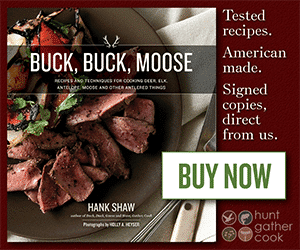


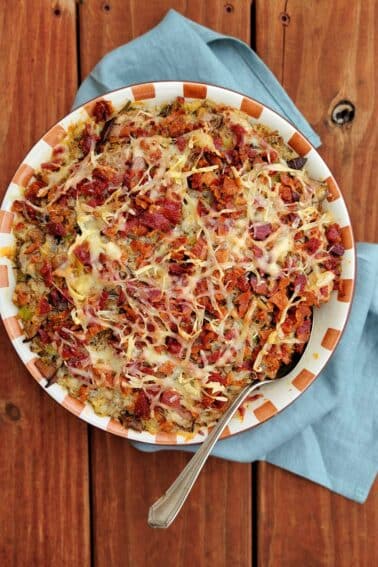

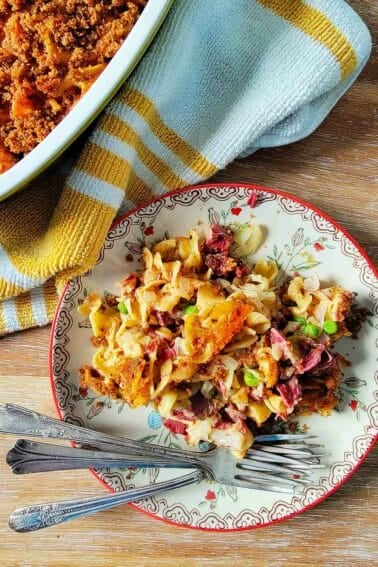
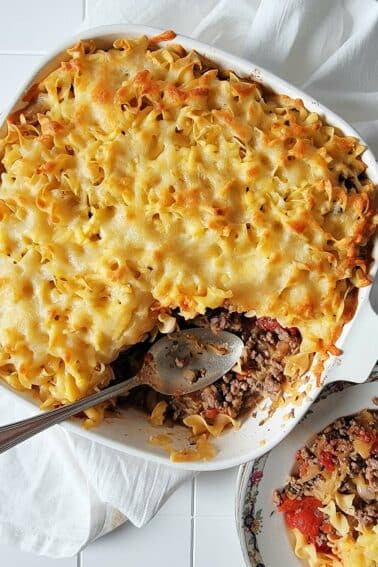
What would you do with a 10 lb. hind quarter? Would you remove the silver skin?
Great recipe and site, Hank. I am a reformed ground venison guy, used to grind most of my deer but have seen the light.
A tip: try removing shanks with your knife. Its a little tricky, but only at first. With the shank folded against the ham work a stout but small knife into the joint to begin separation. Then move along the medial edge of the joint. The joint will open right up and you will be able to cleanly remove the shank.
Did this for Christmas dinner this year, including the dumplings. Roasted the meat on the grill as the oven needed to be at different temperatures and it turned out perfectly. I used a roasted garlic and rosemary infused olive oil for basting. I added some crushed juniper berries for added flavor. I did find I had to continue adding liquid throughout. I took it off around 115 or 120. My father-in-law (the hunter and provider of the roast) said I nailed it. On the dumplings, i ended up starting with them too loose and they fell apart. But I just added a little flour and made the rest of them and they turned out great. Thanks!
I love the dumpling recipe! My Grandmother used to make Knedlikhi (them my mother, and now I do) with a very similar pork roast recipe. I think I will add this meal to my menu for next week.
Hank you are the MAN! I got a beautiful little spike on Thanksgiving. I’ve been dying to try your recipes for a few years now and I finally can (I also have a hard copy of your book on order). I finally decided my first venison roast had rested long enough and sliced off a couple of pieces. Tastes like (better) than high-end grass-fed beef. Wonderful recipe, thank you!
Val: Rolling boil was your problem. I never let the water get above a gentle simmer. Boiling can blast the dumplings apart. Glad you liked the recipe though!
The husband and I made this recipe for a holiday dinner party last night. We used 3 2lb venison legs deshanked and cleaned… I have to say, it was one of the best meals I’ve ever eaten. Thank you so much for putting in all the little details! It helped us big time during the preparation. It only took 20 mins at 450 and another 20 mins at 350 to become perfectly cooked to a temp of 130. We were only 6 people and we literally had scraps left.
I do have a question about the bavarian dumplings. Only half of them turned out, the other half broke apart in the water. Any thoughts? I made them to spec and had the water at a rolling boil. The ones that came out were quite delicious tho and paired perfectly with the venison and cran/apple compote I made.
Hank
I know this is an old post but I am wondering how you deal with the large gland,lymph node? between the top and bottom round when roasting a whole haunch. I don’t know if it affects the flavor of the roast, but it certainly looks unappetizing. Do you try to remove it before cooking, or just carve around it to serve.
Used this recipe last night for deer I had in the freezer and it turned out wonderful. Served it up with some wheat bread & duck fat stuffing, cranberry sauce, and creamed spinach and it was just like Thanksgiving. My photos (https://holytacosdelenguabatman.tumblr.com/post/50442399781/roasted-venison-courtesy) did not turn out as fancy as yours, alas, but needless to say, this recipe is a new staple in my repertoire. Can’t wait for deer season here in NJ!
Great advice! I love the bacon idea. I have one suggestion to offer.
I believe the bone will actually make the temperature lower as bone does not transfer heat well. As a profesional chef, I tell my staff to take a temperature next to, but not in contact with, the bone. By being close to the bone you are getting a reading that is the lowest internal temperature of the muscle.
regards,
David
Dan: the shank is the last digit of the hind leg. Above the hooves but below the ham. You remove it with a hacksaw.
Hey Hank,
Your recipe calls for a hind leg of venison with the “shank” removed.
Would you mind clarifying for me what the shank is? And how to remove it?
Thanks so much,
Dan
Austin, TX
Thanks for the helpful tips! Do these same ground rules hold for a leg of young boar? I notice that there are no recipes for large roasts of boar…
Mike: Never used a larding needle, but since they were in common use for a century, I am betting they work pretty well…
Hey Hank,
I’ve done quite a few large roasts both deer and elk (although not may bone-in)…generally sear them on a nuking hot grill first then finish in medium hot oven. Works out great flavor-wise. I just got myself a larding needle and plan on trying it with garlic, lardons, fresh herbs, etc in larger elk roasts. Just curious if you’ve had any experience with this or have heard of others doing it. Love the flavors of larger, leaner roasts but crave the juiciness that internal fats adds the the mix.
btw, just did 3 large elk roasts using your “corned” recipe….wow…a real revelation. Thanks for that.
Best,
Mike
Hi Hank,
I’m jealous of your access to antelope! I have to chime in on Keith’s comment. You may be right about the diet affecting flavor (and who knows what the white tail deer in southern Michigan have been eating besides my garden), but the larger issue is the melting point of their tallow. The melt point is higher than beef tallow, so it solidifies at body temperature. The result is your mouth will feel like it’s coated with Crisco and candle wax. As I understand it, this melt-point issue is unique to white tail deer.
Back in the day, the guys in my family would not remove the fat and fry up these steaks well-done, fat and all, and the ladies hated them. Now that I’ve learned how to age and butcher this animal, my elderly mother loves a rare venison roast on the grill for Christmas. I’ve had those steak abominations and they were gross, so yeah, the fat freaks me out!
On the other hand, the younger the deer the less tallow between muscle groups, so your 8-pound rule may avoid the issue entirely.
Happy New Year! I look forward to a new year of posts from your, and hope the duck book is coming along as planned.
Hank, great info, I actually roasted a whole small doe on my rotating pig cooker a couple of weeks back, and we are doing another for New Years. Wrapped the spine/backstrap in bacon then foil your tip for searing first would have been spot on as that portion did not have that great roasted look. Stuffed the chest cavity with a whole chicken which itself was stuffed with sticks of butter to get a slow release of juices, also injected with a butter/hot sauce solution every time I went in to add coals. This was a very small doe @ 45lbs before field dressing, flavor was fantastic, not sure yet if that was because it was so young or if we just stumbled on a great cooking method. We’ve got a 60+ pounder hanging in the cooler for New Year’s so may be able to answer that question. Any additional suggestions on improving what seemed to work, the garlic slices I’ve used in legs of lamb before sounds good. Thanks, TL
Keith: The tallow will taste wonderful on a whitetail that had been eating grain crops. I only trim fat off deer in desert or sagebrush areas. It’s an old wives’ tale about whitetail fat tasting nasty.
As for silverskin, yeah, it totally is an issue for a large deer. That’s why this recipe is mainly for yearlings or young animals. I would never do this with a decent buck, for example.
How does all of the embeded tallow, silver skin etc on a typical whitetail hind quarter effect the taste of this recipe. I have always been under the impression that you had to get rid of this as much as possible.
Keith
The venison recipe looks great and doable. Will have to look at it for possibly a moose roast, as deer in the is area are nonexistent.
Had to laugh as I read the title as I have a moose roast, after marinating for a week, in the oven for our holiday meal AND German ‘potato balls’ which are very similar to your ‘dumplings’. Ours have a potato base, riced and the boiled.
Will have to drop in more often. Thanks for the good read on roasting!